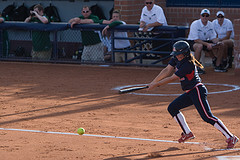Here at North Dakota State University, we have always had a “slap hitter” in our lineup. We have converted seven right-handed batters into left-handed slap hitters since 1995. It’s been a vital part of our defensive philosophy and our success on the diamond.

We look for quickness and speed out of the batter’s box from home to first. Body type doesn’t matter too much. Our most recognizable slap hitter, All-American shortstop Nikki Flynn Gregg, was 5’2”, while this year’s team had outfielder Heather Hyatt at 5’9”. Hand-eye co-ordination is important.
Description of a Slap Hitter
They are in the left-handed batter’s box. The slap hitter runs toward a ball that is moving toward her with the goal of making contact. Her goal is to put the ball in play, to the left side of the infield and utilize her speed to get on base and put pressure on the defense.
The slap hitter is usually the No. 1, No. 2 or No. 9 hitter in lineup. The slapper has to be probably the most disciplined hitter on your team. They have to know the strike zone, the umpire’s strike zone and know what the pitcher is capable of throwing.
Instead of taking a full swing, the slap hitter runs toward the pitcher and tries to make contact by bunting or slapping at the ball. We believe footwork is a key element. What we teach our players is that as they make contact when the left foot is planted, the right foot is slightly in the air, and the left foot is pushing off toward first base. This allows for a more continuous motion instead of stopping, hitting the ball and sprinting toward first base.
We have our slap hitters choke up on the bat as far as possible, almost up to the neck of the barrel. They are not going to have that long of swing or a big swing like the No. 3 or No. 4 hitters. The slap hitter has to make sure to put the bat on the ball and put the ball in play.
We teach our slap hitters to make sure they keep their right shoulder in, keep their hands inside the ball, hit the ball to the left side as they are pushing off so they keep their hands in and to show them where we want them to hit the ball. We see more and more slap hitters pulling the ball because they are getting busted inside.
What a Slap Hitter Can Do For An Offense
If there are runners on base, the slap hitter can force defenses to line up in different positions. The slap hitter has usually been our leadoff hitter, and has been that player who can get on and steal a base. We like to have two slap hitters hitting back-to-back in the line-up in the lineup, which allows you to do more things on offense and puts even more pressure on the defense.
You can call for a hit-and-run, a sacrifice bunt or a drag bunt.
Bunting is a huge part of slap hitting. The slap hitter has to have the ability to read the defense and to pick out where to bunt the ball. They have to study the defense, watch the corners. Sometimes they have to drag bunt or drop the bunt in front of the pitcher or slap the ball down the left field line.
Several Myths About the Slap Hitter
The most common myth about the slap hitter is that they can’t swing away or they can’t hit with power. I believe that is wrong. With the technology and the strength of the players today, there are a lot more slap hitters who can drive the ball to the outfield, and are multi-dimensional and can swing away.
Another common myth is the slap hitter is that they are just fast players. Speed is nice, but the slap hitter has to be tough. They are going to get inside pitches and might get hit a couple of times. We encourage our slap hitters to get right back at it during the next at-bat.
Here’s a couple of drills we’ve used when converting the right-handed batters into left-handed slap hitters.
Footwork
1) First Step
2) Cross over step
3) Walk a straight line
4) Jog a straight line
5) Run a straight line
6) Catch ball off pitching machine (with glove)
7) Catch ball on first step off pitching machine.
8) Catch ball on the run off pitching machine.
Swinging:
1) Wall swings
2) Walking fence drill
3) Walking slap taking a dry swing with tee and no ball.
4) Jogging slap with tee and ball.
5) Jogging slap with tee and dot on in side of ball for contact point.
6) Hitting while pushing off with left leg with tee and ball.
7) Full speed with tee and ball.